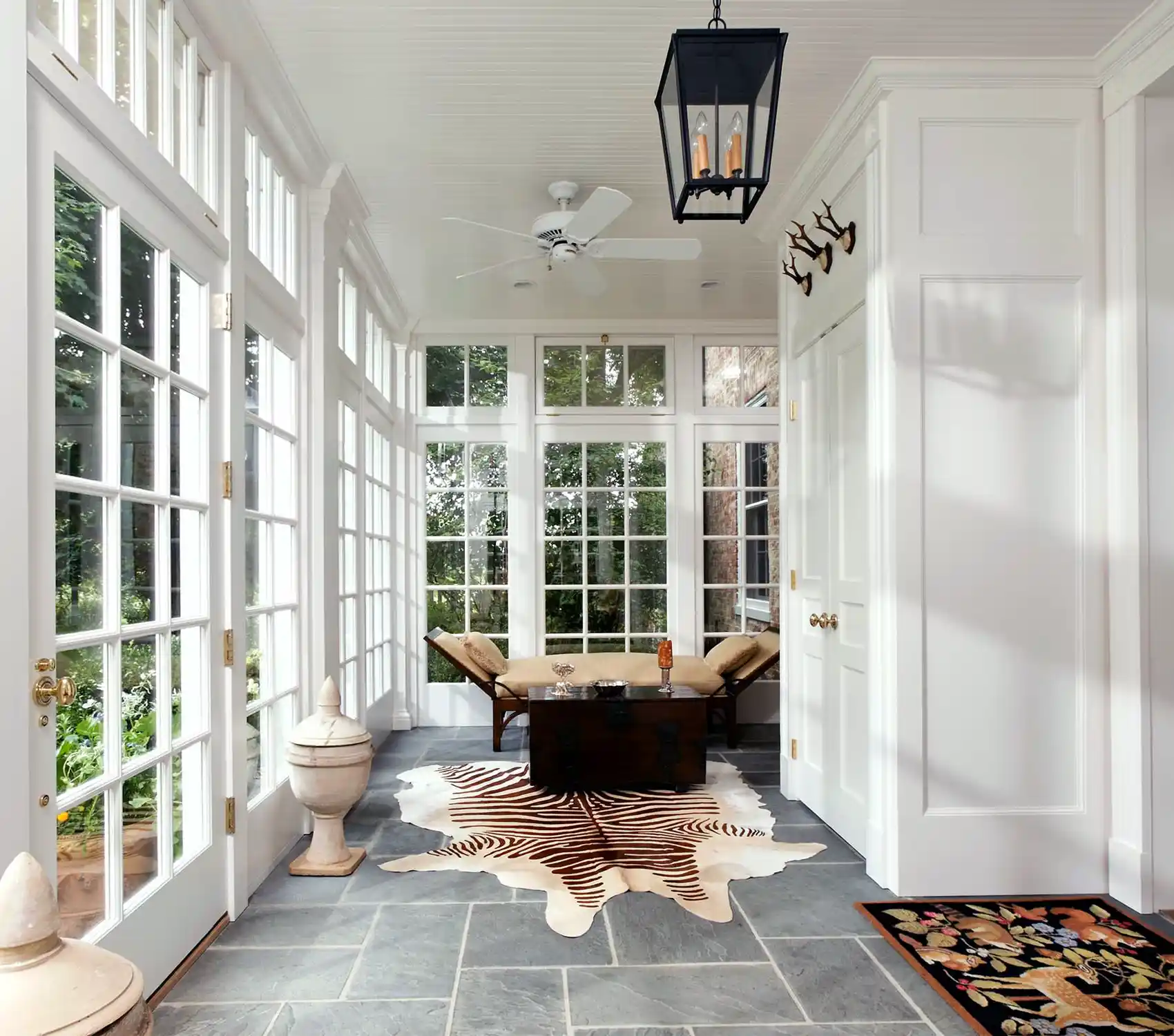
Are Sunrooms Hot?

By John Mazzuca | About | More Posts |
John Mazzuca is a custom home builder with over 25 years experience in the construction industry. John has designed, managed, and built hundreds of homes & construction projects.
Sunrooms are designed to be bright and warm because of all the windows and natural light. But this defining feature can also make them uncomfortably hot, particularly during the Summer months. The primary reason sunrooms get hot is the greenhouse effect; sunlight passes through the glass, warming the surfaces inside, which then radiates heat. Without proper ventilation or shading, the heat trapped by the glass can cause temperatures to rise significantly.
The glass used to build a sunroom can essentially turn it into a greenhouse, allowing sunlight to enter and heat the room. But unlike a greenhouse, which is designed to retain heat for plant growth, a sunroom can become too hot for comfort without ways to mitigate the heat.
To prevent a sunroom from overheating, several strategies can be employed.
- Blinds or shades can be drawn during the hottest parts of the day to block direct sunlight. Reflective window films can also be applied to the glass, reducing the amount of heat that enters without sacrificing too much natural light.
- Proper insulation is crucial; insulated glass units with low-E coatings can help keep the heat out.
- Ventilation is another key factor; ceiling fans can circulate air, and operable windows can allow for cross-ventilation.
- Strategically placed landscaping can provide natural shade without compromising the aesthetic appeal of the sunroom.
- Air conditioning can be used to maintain a comfortable temperature. Whether it’s a standalone unit or an extension of the home’s central system, air conditioning can offer respite from the heat.
I’ve been a NJ sunroom contractor for over 25 years and can tell you firsthand how hot a sunroom can get in Summer. But with certain measures, the room can be made more comfortable in the hottest Summer months.

Are Sunrooms Hot in Summer?
Sunrooms are designed to soak up sunlight, making them inherently warm places. In the summer, this can lead to them becoming quite hot. The primary reason for this is the greenhouse effect. As sunlight passes through the glass, it warms the air and surfaces inside the sunroom, and the enclosed space traps the heat, causing temperatures to rise.
The level of heat within a sunroom during summer can vary depending on several factors.
The direction the sunroom faces, the type of glass used, the presence of ventilation, and the amount of shading can all influence how hot it gets.
Sunrooms facing south or west typically receive more direct sunlight and can become hotter than those facing north or east.
The type of glass is also crucial; standard glass doesn’t protect against UV rays or insulate against heat. Specialized, low-E treated or tinted glass can significantly reduce heat absorption.
Luckily there are some things you can do to keep a sunroom cool in Summer.
Using blinds or shades to block out direct sunlight during the hottest parts of the day, installing ceiling fans to improve air circulation, and ensuring that windows can be opened to create cross-ventilation can all help.
Applying reflective films to the glass, using insulated glass units, and incorporating external shading structures like awnings or planting deciduous trees can provide relief from the heat, and air conditioning is a huge help.
Sunrooms can become very hot in the summer due to their design and the natural process of the greenhouse effect. However, with thoughtful design choices and the implementation of cooling strategies, the heat can be managed to maintain a comfortable and enjoyable space.
Ways To Keep A Sunroom Cool in Summer
Keeping a sunroom cool during the summer can be a challenge because of all the windows and natural light. But there are several ways to deal with the heat and make the room more comfortable.
One of the best ways to keep a sunroom cool is by controlling the amount of sunlight that enters. Window treatments such as blinds, shades, or curtains can be used to block the sun during peak hours. Reflective window films can be applied to the glass to not only prevent excessive heat from entering but also protect against UV rays that can fade furniture and flooring.
Proper ventilation is also crucial. Ceiling fans can promote air circulation, making the room feel cooler and more comfortable. Operable windows or vents will allow for cross-ventilation to draw out the hot air and bring in a cooler breeze.
Insulation plays a significant role in temperature control. Upgrading to insulated glass windows with low-E coatings can prevent heat from penetrating the space. For existing sunrooms, adding insulation to the roof and walls can help maintain cooler indoor temperatures.
Portable air conditioners or standing fans can be used to lower the temperature. These are particularly useful as they can be used as needed and don’t require permanent installation.
A mini-split air conditioning system can also be installed. These systems are efficient and don’t require ductwork, making them ideal for sunrooms.
The strategic use of landscaping can provide natural shade. Planting trees or tall shrubs near the sunroom can block direct sunlight, significantly reducing heat gain.
Awnings or pergolas can be installed outside to provide shade without obstructing the view.
Sunrooms can get hot because of all the glass and sunlight, but the room can be made more comfortable in Summer if you take the right steps to mitigate the heat.
Are Sunrooms Hot in Winter?
Sunrooms have lots of large windows that let in natural light. With that light comes heat and the greenhouse effect, which can make the room feel hot in peak hours of the day. But during Winter, sunlight becomes weaker and days shorter, so sunrooms can vary in temperature.
In regions with mild Winters and plenty of sunny days, a sunroom may stay pleasantly warm due to the passive solar heat gained through the glass. But in areas with harsher winters, without direct sunlight to warm the space, a sunroom can become quite cold.
The insulation quality of the sunroom plays a very significant role. Three-season sunrooms aren’t typically built with the insulation necessary to retain heat in colder months. This makes them chilly spaces in winter without additional heat sources. But four-season sunrooms are designed to be used in Winter, so they have more insulation. These types of rooms have a tendency to get hot in Winter because heat can’t escape.
To maintain warmth in a sunroom during winter, heating solutions can be used.
This can range from portable heaters for occasional use to more permanent solutions like extending the home’s HVAC system into the sunroom or installing a ductless mini-split system.
Insulating the sunroom with double or triple-glazed windows, insulated walls, ceilings, and floors, and proper roofing materials can also help retain heat.
While sunrooms can capture and retain some heat during sunny Winter days, they’re not inherently hot during the colder months and often require additional heating and insulation measures to be comfortably used throughout the winter. However, when well insulated, a sunroom can get quite hot in Summer because the heat has no way to escape.
Are Sunrooms Hot At Night?
Sunrooms are designed to allow in lots of natural light, which brings heat with it. This can cause them to be hot during the day because of the greenhouse effect, especially in Summer. But at night the dynamics change. While a sunroom can remain warm after sunset, particularly if it’s been absorbing and storing heat throughout the day, the temperature typically drops once the sun goes down.
The extent to which a sunroom stays hot at night depends on several factors, including the materials used in its construction, the presence and effectiveness of insulation, and the local climate.
In regions with cooler evenings, the temperature inside a sunroom can become much cooler at night. But in areas where the nights remain warm, or if the sunroom isn’t well-ventilated, the heat accumulated during the day can cause the temperature to stay elevated into the night.
This is particularly true for sunrooms made with materials that have high thermal mass, like stone or brick. Masonry can radiate heat for hours after the sun has set.
Shades or blinds can block out the sun during the hottest part of the day. This can prevent some of the heat from being trapped.
Ventilation is also key; opening windows and doors in the evening can help release stored heat, allowing cooler air to circulate.
Using fans can aid in moving the air around, contributing to a cooler feel, and air conditioning can cool the room at any time.
While sunrooms can be hot at night due to heat retention, the actual temperature will vary based on the design of the room, the outside climate, and any cooling measures that are in place.
If you have any questions or comments email or leave a comment down below.

John Mazzuca | About | More Posts |
Custom Home Builder
John Mazzuca is a custom home designer and builder at Gambrick with over 25 years experience in the construction industry. John has designed, built and/or remodeled hundreds of homes, small buildings, and commercial projects. He writes about business, real estate, home building, and household electronics. His work has been featured in Fox Business, Better Homes & Garden, House Beautiful, and more.




















